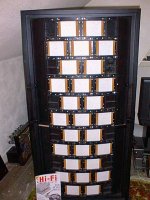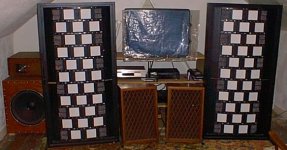I just got a pair of these in big cabinets...
I need to make space and i'm throwing away the cabinets but i wanted to check the drivers before.
My dad had them constructed in 1956. He says the drivers are german.
Single wideband driver it seems, in a cabinet around 100*50*30 cm vented (one big rectangular vent). No filters, no foam or anything inside the cabinets.
Is it worth keeping on a shelf or something ?
Here is a picture of the front... the big thing in the middle seems to be the motor/magnet.
Next is the back of it... Spider-less...
And finally the connections... weird weird thing. The plate doesn't move, it is fixed to the structure that is in the front... it makes me think of some bass-shakers projects some did with bass drivers.
I need to make space and i'm throwing away the cabinets but i wanted to check the drivers before.
My dad had them constructed in 1956. He says the drivers are german.
Single wideband driver it seems, in a cabinet around 100*50*30 cm vented (one big rectangular vent). No filters, no foam or anything inside the cabinets.
Is it worth keeping on a shelf or something ?
Here is a picture of the front... the big thing in the middle seems to be the motor/magnet.
An externally hosted image should be here but it was not working when we last tested it.
Next is the back of it... Spider-less...
An externally hosted image should be here but it was not working when we last tested it.
And finally the connections... weird weird thing. The plate doesn't move, it is fixed to the structure that is in the front... it makes me think of some bass-shakers projects some did with bass drivers.
An externally hosted image should be here but it was not working when we last tested it.
Verrry interesting. This technique seems to pre-date some woofer drive unit designs which are appearing for cars, as it makes a very slim unit. So you can put a big drive unit in a door for example. I think Bose are using this principle. They probably have a patent on it, but this would prove prior art.
The mechanics is brilliantly simple as it is punched out of a steel sheet. Can we call it the AAS design *** about face?
The mechanics is brilliantly simple as it is punched out of a steel sheet. Can we call it the AAS design *** about face?
I had a funny feeling that i would know what these are.
So i hope i am right.
GE'GO
was Gerard Gogny and Marcel Poutot.
They are french.
They took the german Blatthaller design and came up with the GE'GO ORTHOPHASE speakers.
I have a pair of 1959 OR3 W4 which were built in 1959 by the RADIO PEOPLE LTD Hong Kong under licence..
They have 4 eliptical bass drive units and 3 Orthophase planar ribbon drive units.
L'Audiophile wrote an article on the history of Orthophase and GE'GO in about 1990.
The company was based in Paris from about 1955- mid late 60's.
Then in 1970's Ernst Spiteri set up ESL of Paris and manufactured the orthophase drive units with a few improvements.
I have a pair of his OR27.
Ernst designed the Aqualung with the famous French Underwater explorer Jacques Cousteau.
Eithetr Gerard Gogny or Marcel Poutot designed the torque wrench.
So the drive units photgraphed must be a different drive unit to the Orthophase.
There is also a mention in Gilbert Briggs book More About Loudspeakers dated 1960?
ESL and Ernst Spiteri built some of the craziest loudspeakers turntables andamplifiers that i have ever seen
I have several photos of his equipment taken when i visited Ernst in Breatgne in about 1990 and 1991.
He was a lovely chap.
I hope the above is of interest.
I use my OR27 in my AV system as the main speakers. I dont currently use the OR3 W4.
regards David
So i hope i am right.
GE'GO
was Gerard Gogny and Marcel Poutot.
They are french.
They took the german Blatthaller design and came up with the GE'GO ORTHOPHASE speakers.
I have a pair of 1959 OR3 W4 which were built in 1959 by the RADIO PEOPLE LTD Hong Kong under licence..
They have 4 eliptical bass drive units and 3 Orthophase planar ribbon drive units.
L'Audiophile wrote an article on the history of Orthophase and GE'GO in about 1990.
The company was based in Paris from about 1955- mid late 60's.
Then in 1970's Ernst Spiteri set up ESL of Paris and manufactured the orthophase drive units with a few improvements.
I have a pair of his OR27.
Ernst designed the Aqualung with the famous French Underwater explorer Jacques Cousteau.
Eithetr Gerard Gogny or Marcel Poutot designed the torque wrench.
So the drive units photgraphed must be a different drive unit to the Orthophase.
There is also a mention in Gilbert Briggs book More About Loudspeakers dated 1960?
ESL and Ernst Spiteri built some of the craziest loudspeakers turntables andamplifiers that i have ever seen
I have several photos of his equipment taken when i visited Ernst in Breatgne in about 1990 and 1991.
He was a lovely chap.
I hope the above is of interest.
I use my OR27 in my AV system as the main speakers. I dont currently use the OR3 W4.
regards David
David,
That info is fascinating but does the term orthophase apply to the magnet in front of the speaker?
The units are well worth keeping in view of the present use by Bose of the technique.
Bose won 2003 General Motors supplier of the year award on the strength of their car speaker technology now used by Audi as well. The technology is called Nd which sort of refers to the Neodynium magnet used to achieve a small magnet design.
I guess the Ge Go used an Alnico magnet to the same effect
I know this forum has a downer on Bose but fair do's to their systems in cars.
The 3 letter acronym should of course be AAF
That info is fascinating but does the term orthophase apply to the magnet in front of the speaker?
The units are well worth keeping in view of the present use by Bose of the technique.
Bose won 2003 General Motors supplier of the year award on the strength of their car speaker technology now used by Audi as well. The technology is called Nd which sort of refers to the Neodynium magnet used to achieve a small magnet design.
I guess the Ge Go used an Alnico magnet to the same effect
I know this forum has a downer on Bose but fair do's to their systems in cars.
The 3 letter acronym should of course be AAF
Orthophase related to the fact that you had a ribbed polystyrene flat diaphragm 10cm x 10 cm.
Thrre were 15 ribs on the back of the diaphragm upon which the 15 element ribbon was applied.
So you had 10cm x 10cm diaphragm driven over its whole area.
They were full range and when used in multiples over 6 needed no auxiliary bass driver.
27 in series like mine have an impedence of approx 6ohms.
The chassis can be interlinked so you can have close grouping of the drive units
regards David


Thrre were 15 ribs on the back of the diaphragm upon which the 15 element ribbon was applied.
So you had 10cm x 10cm diaphragm driven over its whole area.
They were full range and when used in multiples over 6 needed no auxiliary bass driver.
27 in series like mine have an impedence of approx 6ohms.
The chassis can be interlinked so you can have close grouping of the drive units
regards David


Attachments
I suspect that trying to treat them will be more likely to damage them than just running them the way they are. Older speakers often have quite stiff suspensions. I wouldn't assume that they are stiffer than they were. As you say, the suspension is the same material as the cone. If the suspension were flexible, the cone would also be flexible, and pretty worthless, so I think they are probably fine. I doubt that they were designed to have much x-max (excursion) at all.
If they had used a suspension like we use today, it probably would have rotted away!
You could try them at very low volumes at first....
If they work, then maybe try them in a hole in the middle of a 4'x4' piece of plywood (open baffle) They might sound pretty good!
Volt (from England) currently uses a similar magnet/front frame setup. I'll bet they think they invented it!!
If they had used a suspension like we use today, it probably would have rotted away!
You could try them at very low volumes at first....
If they work, then maybe try them in a hole in the middle of a 4'x4' piece of plywood (open baffle) They might sound pretty good!
Volt (from England) currently uses a similar magnet/front frame setup. I'll bet they think they invented it!!
Bonjour,
Sorry not speak Anglais. je suis Français
Je possede une paire de H.P identiques. A la seule différence c'est qu'ils sont élliptiques.
C'est une marque française des années 60. Si le moteur était devant c'était pour facilité l'intégration dans des coffret de pick-up ("tourne-disques" in French !)
Ces H.P sont fragiles ! L'idéal est de les monter dans une caisse (cabinet) avec event (bass reflex) Et d'utiliser un ampli a tubes (valves)
Voilà
Xib
Sorry not speak Anglais. je suis Français
Je possede une paire de H.P identiques. A la seule différence c'est qu'ils sont élliptiques.
C'est une marque française des années 60. Si le moteur était devant c'était pour facilité l'intégration dans des coffret de pick-up ("tourne-disques" in French !)
Ces H.P sont fragiles ! L'idéal est de les monter dans une caisse (cabinet) avec event (bass reflex) Et d'utiliser un ampli a tubes (valves)
Voilà
Xib
Xib,
Essayez d'écrire en Anglais. Traduction ci-dessous:
Traduction ci-dessous:
Hello,
I’m French, I don’t speak English
I own an identical speakers pair. The only difference is their elliptical form.
It’s a French brand from the sixties. The motor was placed on the front to provide an easy integration with the pick-up box.
These speakers are fragile. Ideally one would mount them in a bass reflex cabinet and use a valve amp.
/Hugo
Essayez d'écrire en Anglais.
Hello,
I’m French, I don’t speak English
I own an identical speakers pair. The only difference is their elliptical form.
It’s a French brand from the sixties. The motor was placed on the front to provide an easy integration with the pick-up box.
These speakers are fragile. Ideally one would mount them in a bass reflex cabinet and use a valve amp.
/Hugo
- Status
- This old topic is closed. If you want to reopen this topic, contact a moderator using the "Report Post" button.
- Home
- Loudspeakers
- Multi-Way
- Can someone identify a speaker from 1956 ?

